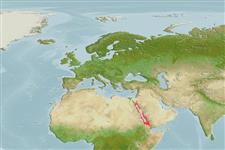Common names from other countries
>
Clupeiformes (Herrings) >
Dorosomatidae (Gizzard shads and sardinellas)
Etymology: Herklotsichthys: After Janus Adrian Herklots, Australian ichthyologist, 1820-1872.
More on author: Rüppell.
Environment: milieu / climate zone / depth range / distribution range
Ecologia
marino; distribuzione batimetrica 0 - 50 m (Ref. 188). Subtropical; 37°N - 12°N, 29°E - 45°E (Ref. 188)
Western Indian Ocean: Red Sea and possibly Gulf of Aden; an immigrant into eastern Mediterranean Sea (Ref. 188). The names Herklotsichthys punctata and Herklotsichthys punctatus have been widely misused in the literature for another species, Herklotsichthys quadrimaculatus (Ref. 188).
Size / Peso / Age
Maturity: Lm ? range ? - ? cm
Max length : 11.7 cm TL maschio/sesso non determinato; (Ref. 124816); common length : 9.5 cm TL maschio/sesso non determinato; (Ref. 5450); peso massimo pubblicato: 15.00 g (Ref. 124816)
Spine dorsali (totale): 0; Raggi dorsali molli (totale): 13-21; Spine anali 0; Raggi anali molli: 12 - 23. Flank silvery, without spots, but a series of small dark spots on back on either side of dorsal fin base or behind it.
Forms schools in coastal waters (Ref. 188). Marketed fresh, dried and dried salted or made into fish balls.
Life cycle and mating behavior
Maturità | Riproduzione | Deposizione | Uova | Fecundity | Larve
Whitehead, P.J.P., 1985. FAO Species Catalogue. Vol. 7. Clupeoid fishes of the world (suborder Clupeoidei). An annotated and illustrated catalogue of the herrings, sardines, pilchards, sprats, shads, anchovies and wolf-herrings. FAO Fish. Synop. 125(7/1):1-303. Rome: FAO. (Ref. 188)
IUCN Red List Status (Ref. 130435)
CITES (Ref. 128078)
Not Evaluated
Threat to humans
Harmless
Human uses
Pesca: scarso interesse commerciale
Informazioni ulteriori
BibliografiaAcquacolturaProfilo di acquacolturaVarietàGeneticaElectrophoresesEreditarietàMalattieElaborazioneMass conversion
CollaboratoriImmaginiStamps, Coins Misc.SuoniCiguateraVelocitàModalità di nuotoArea branchialeOtolithsCervelliVista
Strumenti
Special reports
Download XML
Fonti Internet
Estimates based on models
Preferred temperature (Ref.
115969): 25.1 - 29.4, mean 28.9 (based on 54 cells).
Phylogenetic diversity index (Ref.
82804): PD
50 = 0.5002 [Uniqueness, from 0.5 = low to 2.0 = high].
Bayesian length-weight: a=0.00912 (0.00433 - 0.01920), b=3.04 (2.87 - 3.21), in cm Total Length, based on LWR estimates for this (Sub)family-body shape (Ref.
93245).
Trophic level (Ref.
69278): 3.1 ±0.3 se; based on size and trophs of closest relatives
Resilienza (Ref.
120179): Alto, tempo minimo di raddoppiamento della popolazione meno di 15 mesi (Preliminary K or Fecundity.).
Fishing Vulnerability (Ref.
59153): Low vulnerability (10 of 100).
